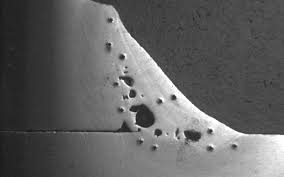What is Porosity in Welding: Understanding Its Reasons and Enhancing Your Skills
What is Porosity in Welding: Understanding Its Reasons and Enhancing Your Skills
Blog Article
Untangling the Secret of Porosity in Welding: Tips for Lessening Flaws and Optimizing Quality
In the intricate world of welding, porosity remains a consistent challenge that can significantly impact the top quality and stability of bonded joints. As we delve right into the depths of porosity in welding, revealing the tricks to its avoidance and control will certainly be critical for specialists looking for to master the art of top notch weldments.
Understanding Porosity in Welding
Porosity in welding, an usual concern encountered by welders, refers to the presence of gas pockets or spaces in the welded material, which can endanger the stability and top quality of the weld. These gas pockets are usually caught during the welding procedure as a result of various elements such as inappropriate securing gas, infected base products, or inaccurate welding parameters. The formation of porosity can compromise the weld, making it vulnerable to fracturing and deterioration, eventually resulting in structural failings.
By acknowledging the significance of keeping appropriate gas protecting, making certain the sanitation of base materials, and enhancing welding setups, welders can considerably decrease the likelihood of porosity formation. Overall, a detailed understanding of porosity in welding is crucial for welders to generate high-grade and durable welds.

Usual Reasons of Porosity
When evaluating welding processes for potential top quality issues, understanding the typical sources of porosity is important for maintaining weld stability and avoiding structural failings. Porosity, defined by the existence of cavities or spaces in the weld steel, can substantially endanger the mechanical homes of a bonded joint. One typical reason for porosity is incorrect securing gas protection. Insufficient shielding gas circulation rates or inappropriate gas mixtures can bring about atmospheric contamination, leading to porosity formation.
Additionally, welding at inappropriate criteria, such as exceedingly high travel rates or currents, can create excessive disturbance in the weld swimming pool, capturing gases and creating porosity. By dealing with these usual causes through correct gas shielding, material preparation, and adherence to optimal welding parameters, welders can minimize porosity and boost the quality of their welds.
Techniques for Porosity Avoidance
Carrying out effective safety nets is crucial in lessening the occurrence of porosity in welding processes. One technique for porosity avoidance is ensuring correct cleaning of the base metal prior to welding. Pollutants such as oil, grease, corrosion, and paint can bring about porosity, so comprehensive cleansing using suitable solvents or mechanical methods is vital.

Utilizing high-quality filler materials and shielding gases that are appropriate for the base steel and welding procedure can considerably lower the danger of porosity. In addition, keeping proper welding parameters, such as voltage, existing, take a trip rate, and gas flow rate, is crucial for porosity avoidance.
Additionally, employing proper welding strategies, such as preserving a constant traveling speed, electrode angle, and arc length, can aid protect against porosity (What is Porosity). Appropriate training of welders to ensure they adhere to ideal methods and quality control treatments is additionally vital in lessening porosity defects in welding

Best Practices for Top Quality Welds
Guaranteeing adherence to industry requirements and proper weld joint prep work are essential elements of attaining constantly top notch welds. In addition to these fundamental steps, there are several ideal practices that welders can execute to further improve the top quality of their welds. One trick technique is keeping proper sanitation weblink in the welding location. Pollutants such as oil, grease, rust, and paint can negatively impact the high quality of the weld, resulting in problems. Completely cleaning the work surface and surrounding location prior to welding can aid minimize these issues.
Another ideal method is to very carefully select the proper welding parameters for the particular products being joined. This includes setting the proper voltage, existing, travel rate, and protecting gas flow rate. Appropriate parameter choice guarantees optimum weld penetration, blend, and total top quality. Making use of premium welding consumables, such as electrodes and filler steels, can substantially affect the final weld high quality. Purchasing costs consumables can lead to stronger, more long lasting welds with less problems. By complying with these finest methods, welders can consistently produce high-quality welds that fulfill sector criteria and go beyond client assumptions.
Relevance of Porosity Control
Porosity control plays a crucial function in making sure the honesty and quality of welding joints. Porosity, identified by the visibility of tooth cavities or voids within the weld steel, can substantially browse around this site endanger the mechanical residential or commercial properties and structural stability of the weld. Extreme porosity damages the weld, making it more prone to cracking, deterioration, and general failure under operational lots.
Effective porosity control is important for preserving the desired mechanical properties, such as strength, ductility, and toughness, of the bonded joint. What is Porosity. By lessening porosity, welders can improve the overall high quality and integrity of the weld, making sure that it meets the efficiency demands of the designated application
Moreover, porosity control is vital for attaining the preferred aesthetic appearance of the weld. Too much porosity not only damages the weld however additionally takes away from its aesthetic allure, which can be essential in industries where looks are necessary. Appropriate porosity control strategies, such as making use of the correct shielding gas, regulating the welding criteria, and making sure correct cleanliness of the base products, are essential for generating high-quality welds with minimal flaws.

Verdict
In conclusion, porosity in welding is a common problem that can jeopardize the quality of the weld. By understanding the sources of porosity and executing proper prevention techniques, welders can lessen problems and achieve higher top quality welds. It is important to regulate porosity in welding to guarantee the stability and stamina of the final item. Executing finest techniques for porosity control is critical go to my blog for attaining ideal welding results.
Report this page